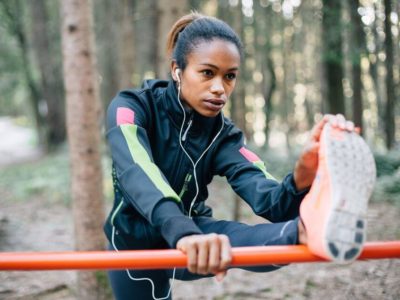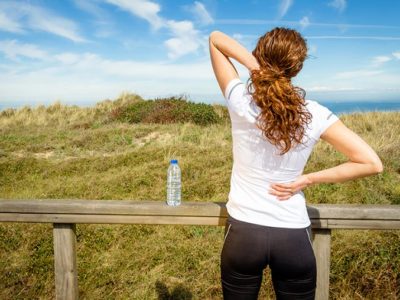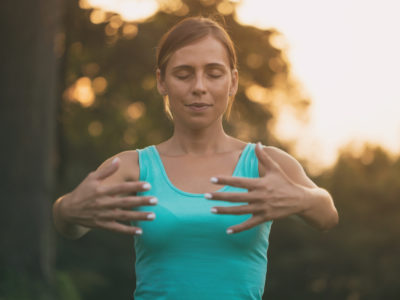Table of Contents[Hide][Show]
Hunching over your phone as you mindlessly scroll.
Sitting at your desk for hours at a time.
Weekends spent lounging on the couch for a Netflix binge.
These are all common scenarios, and they have one thing in common: their negative impact on your muscles.
The lack of movement, coupled with less-than-natural postures, can have the cumulative affect of seriously reducing your mobility.
Let’s take a look at how you can recover your mobility, including some simple exercises that you can do at home.
What Is Mobility?
Before we get into improving your mobility, let’s make sure you understand what mobility is.
Mobility refers to your body’s ability to move painlessly through a wide range of motion. Usually, it describes to the way your joints move within their sockets.
For example, you want to be able to make giant circles with your arm. If you have to bend your arms, arch your back, or make smaller circles on one side, then that’s a sign that your mobility in that joint is restricted.
Although any muscle or joint can experience decreased mobility, your ankles, hips, and shoulders are the most likely to suffer from a reduced range of motion.
For many people, mobility becomes more limited due to either age or injuries.
Luckily, regaining your mobility is possible with the right exercises—and the right attitude!
Mobility vs. Flexibility
Some people use the terms mobility and flexibility interchangeably. Although they’re similar, they are actually two describe two different types of movement.
Flexibility: This is the ability to move through an extended range of motion as a muscle lengthens. The most common way to increase flexibility is by stretching.
Mobility: This is the ability to move with control. You can increase mobility by unlocking the tension in your muscles or by lengthening muscles tissue with targeted stretches and exercises.
What Causes Decreased Mobility?
Let’s be honest: the human body was made to be moved!
Unfortunately, a large number of jobs nowadays are performed on a computer, which means many people spend most of their 40-hour workweek sitting.
The lack of movement gets even worse if you work from home. At least at the office, there was the chance to walk over to the breakroom or to stop by a co-worker’s office. If you work from home, though, there’s an increasing likelihood that you spend most of your day either on the couch, at the dining room table, or in your home office, hardly ever getting up.
Studies show that sedentarism (sitting for too long) over days, weeks, and months can lead to loss of mobility, especially as we age. Conversely, physical exercise and movement can help you regain your mobility.
Aside from decreased physical activity, here are some other factors that may lead to decreased mobility.
- Chronic diseases, inlcuding diabetes
- Cognitive issues
- Depression
- Decreased balance
- Excessive alcohol usage
- Feelings of helplessness
- Impaired strength
- Injuries, especially to the spinal cord
- Obesity
- Older age
- Recent hospitalization
- Repeated stress injuries
- Smoking
6 Tips For Increasing Mobility
We’ve collected the best mobility exercises here for you. But first, let’s go over a few things to keep in mind as you move, stretch, and flex your way back into mobility.
Focus
When you’re working on mobility for a specific muscle, make sure your exercises are working that muscle. Ideally, the rest of your body will be still, and you’ll be able to move the working muscle in isolation.
For example, we talked about shoulder rotation (with arm circles) earlier. In this case, you want to be sure that you’re focusing your exercise on that shoulder/ rotator cuff, and not compensating by arching your back when your arm goes behind you or hunching forward (contracting your abdominal muscles) when your arm circles forward. If you do either of those things, you’re not working on your range of motion as effectively.
Find New Ways to Move
There’s a common saying that goes, “If you do what you’ve always done, you’ll get what you’ve always gotten.”
This certainly holds true for mobility exercises! If you keep moving your muscles in the same ways that you always have, you won’t increase your mobility.
For improved mobility and a better range of motion, you have to challenge your body by pushing it to move in new ways. Going back to our favorite example—shoulder rotations—increasing the rotation by even a degree or two will increase your overall range of motion.
Of course, you always need to maintain the balance between pushing your muscles and overdoing it. It’s okay to feel slightly sore, but range or motions should never cause pain. If it does, stop the exercise and schedule a visit with your doctor or physical therapist.
Practice Pausing
We get it; the world is fast-paced. But if you want to make your mobility exercises yield great results, you have to take your time with them.
Say you’ve noticed that your ankles feel stiff and have decided to loosen them with standing calf raises. You can fly through 10 of them and be done in just a few seconds.
However, if you slow down your exercises, you can actually observe just how far you can flex your ankles and feel each degree that you move. Next time you do the same exercises, you can push yourself to go a little further with your range of motion.
Over time, you’ll be able to notice the improvements in your range of motion and overall mobility.
Slow and steady beats fast and rushed, every time!
Take Deep Breaths
Pushing your muscles to increase mobility might feel awkward or uncomfortable, especially if it’s been a while since you went that far.
That feeling of discomfort is transmitted to your central nervous system, which might react by tensing up and actually decreasing your range of motion.
To combat this, you can take deep breaths as you move your muscles. This will signal to your nervous system that everything is okay and prompt it to allow your muscles to relax.
Related
The Deep Breathing Detox: Could Better Breathing Lead to Better Health?
Practice deep breathing techniques, exercises, and other methods to drive away stress with these tips!
Stay Warm
We don’t just mean the temperature in your home!
Warm muscles are looser and move more easily. This is why we warm up before strenuous exercise, so that your muscles move naturally and freely.
If you sit in one position for too long, though, your muscles will get cool. When you get up, they may even feel stiff and take a while to reach optimal movement.
To keep your muscles warm and loose, try to avoid sitting in the same position for too long. During your workday, stand up and walk around occasionally. If you’re watching television, get up during commercial breaks.
Practice Myofascial Release
Your muscles are wrapped with tough myofascial tissues that connect and support your muscles.
When these tissues are too tight, they pull on the muscles and limit your range of motion. For example, if your hamstrings are tight, they can contract and pull back on the myofascial tissue around your hips. This causes your hips to rotate outwards, resulting in limited mobility and, often, soreness or even pain.
Myofascial release targets the tight muscles and relaxes them to increase your range of motion and decrease any pain.
Massage is one of the best ways to release the myofascia. A licensed massage therapist can note which muscles are tight and work with them to release muscular tension, leading to an increased range of motion.
You can also practice self-mysofascial release, (SMR), also known as self-massage. For the most part, it’s difficult to achieve with just your hands, since many areas are difficult to reach on your own.
Luckily, there are tools that can help you with SMR, such as foam rollers and massage guns. Even a tennis ball or lacrosse ball can be used.
Myofascial release works best in conjunction with strength training. This doesn’t mean lifting heavy weights at the gym. In this case, strength training refers to exercises that strengthen your muscles. You can use low weights or your body weight.
Related
Park Over Gym: 10 Strengthening Moves You Can Do Amidst Nature
In the Information Age, serious trainees and weekend warriors everywhere are waiting on technology to deliver the next great innovation to the doorstep of the fitness arena. With all of the bells and whistles being promoted as necessary to get ripped, shredded, and downright crazy lean, many have fallen into the “I need a gym …
Best Exercises for Mobility
Ready to do away with those tight muscles and regain your mobility? Here are some exercises to get you started.
How to Improve Ankle Mobility
Calf stretches (on a ledge or step) – Stand on the ball of your feet at the edge of a step or other ledge. Press your heels down towards the floor and hold for a few seconds, gradually increasing time and reps over time.
Foam roll calves – Place a foam roller under the middle of your calf. Roll up and down from below your knee to your ankle. Rotate your leg in then out. Switch roller to other leg and repeat. Gradually increase reps over time.
How to Improve Hip Mobility
Hip circles – There are several different ways you can do hip circles. Below is a quick video demonstrating standing hip circles.
Hip openers – Lacking mobility in your hips typically places more pressure on your spine, which can lead to back pain among other unpleasant symptoms. Practicing hip opening stretches can help relieve this pressure and increase mobility. Watch the video below for a couple of simple hip opener stretches.
Deep squat into frog pose – A frog pose is a stance where the legs are spread wider than the hips and the toes are pointed out, like the shape of a frog. You can do this exercise as a transition between poses (shown in the first video) or as a variation on a traditional squat exercise where you raise and lower you body (as in the second video). See what works for you and increase difficulty as your mobility improves.
Figure 8 stretches – This is a great exercise if you sit most of the day. There are many ways to incorporate this exercise into dancing to make it more fun. Here are a couple of hip figure 8 examples.
Myofascial release of glutes and hips (with tennis balls) – This stretch involves rolling out the tight areas in your glutes and hips using tennis balls. Alternatively you could use lacrosse balls or purchase some acupressure balls if you prefer. Here’s a demo of how it’s done.
How to Improve Shoulder Mobility
Arm and shoulder circles – These are a great beginner mobility exercise. Simply stand with your feet shoulder-width apart and your extend arms parallel to the floor. Move your arms in small circle forward motions. Gradually extend to larger circles until you feel your triceps stretch. Repeat in the opposite direction after 10 seconds.
Hitchhikers – This exercise can be performed again a wall or lying on the floor. These involve stretching your arms out in front of you with your thumbs up (hence the name “hitchhikers) to work the trap muscles. Pull your shoulder blades down and in while holding your arms up. Here is a quick video demo.
Chest and shoulder openers (with a weight) – With some light dumbbells, lay down on a bench, and start with your arms together in the air, and open all the way out and down in a relaxed motion. Check out this quick video to see how it’s done.
Snow angels (with a foam roller) – Place a foam roller on the ground vertically. Lay with the roller along your spine, supporting your hips, upper back, and head. Place your arms at your side in a comfortable resting position. Slowly raise your arms above your head and back down as if you are making a snow angel. Be sure not to arch your back.
Probiotics and Mobility
Although probiotics aren’t specifically made to increase muscle mobility, they should form a part of any wellness routine.
The list of probiotic benefits, which continuously grows longer thanks to medical research, includes reduced inflammation, especially that associated with rheumatoid arthritis and other chronic illnesses. Inflammation can cause muscle pain and reduced range of motion.
Probiotics also help your body with optimal nutrient absorption, which is necessary to have the energy needed to stretch, flex, and generally get up and move. Consider a daily probiotic supplement to support digestion, immune system, and overall health. Our favorite is Just Thrive Probiotic because it is guaranteed to arrive 100% alive in your gut and has 1000x better survivability vs. leading probiotics.
Final Thoughts
Whether it’s through injury, age, or a sedentary lifestyle, loss of mobility is a common experience.
However, you don’t have to resign yourself to tight muscles, limited range of motion, and painful movements.
The mobility exercises and stretches listed above can help you get back on track to feeling strong, loose, and ready to live a healthy, active life!
You May Also Like…






